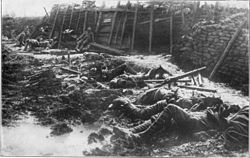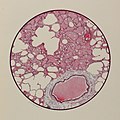Chemical weapons in World War I
In World War I, chemical weapons were used often. They were a major part of the war.[1] This was the first time in history that chemical weapons were widely used in warfare.[2]
Poison gas attacks were a very effective way of attacking the enemy from a distance, without direct contact. Tear gas, chlorine, phosgene, and mustard gas were all used during World War I (WWI).[3]
Soldiers tried to protect themselves using gas masks, but they were big, clumsy, and did not always work. Soldiers on both sides could be poisoned in a gas attack, because the wind would often blow gas back towards the attackers. For these reasons, soldiers in the trenches feared gas attacks more than anything else.
History

WWI began in 1914. The two sides (the Triple Alliance and the Triple Entente) competed against each other to build better fighting technology that would win the war.
The French were the first to use poison gas in the war, in 1914 against the Germans. The following year, on 31st January 1915, the Germans launched over 18,000 shells (very large bullets) filled with tear gas towards the Russians.[4] (This attack failed.)
Chlorine gas was first used on the 22nd of April 1915, by the Germans against French Algerian soldiers at the Battle of Ypres. Thousands of soldiers smothered in the attack.[4] Even the Germans, who launched the attack, did not realize chlorine's effects were so deadly. Instead of pushing forward they retreated, missing a huge opportunity.[5]
Britain first used gas in December of 1915. Many British people thought this was inhumane, and there was a public outcry that continued even after the war. The commander of British Expeditionary Force, Sir John French (who had previously criticized the use of gas in warfare) stated:[4]
[Because of] the repeated use by the enemy of asphyxiating gases in their attacks on our positions, I have been compelled to resort to similar methods.
Years before, a law was signed forbidding the use of poisonous gases in war. For this reason, the factories that manufactured the gases called them an "accessory" instead of a "gas."
The factories that manufactured the gases were not allowed to call them gases. An act had been signed years before forbidding The gas was referred to as an accessory.
Adolf Hitler was the victim of a gas attack while fighting in WWI. For this reason, he refused to use poison gas attacks during World War II.[6]
Types of gas
Several types of poison gases were used during WWI.
Tear gas
See the main article: Tear gas
Tear gas was effective, but not deadly. It was first used by the French in 1914.
Chlorine gas
See the main article: Chlorine
Chlorine gas was very deadly. It painfully damaged the eyes, throat, nose, ears, and lungs. Then it caused death by asphyxiation.[7]
Chlorine gas is a highly visible green cloud. It was first used by the Germans in April 1915 at the Battle of Ypres, where it killed around 1,100 French Algerian soldiers.[1][5]
According to James Patton:[1]
Chlorine’s usefulness was short-lived. Its color and odor made it easy to spot, and since chlorine [dissolves in water,] even soldiers without gas masks could minimize its effect by placing water-soaked - even urine-soaked - rags over their mouths and noses. Additionally, releasing the gas in a cloud posed problems, as the British learnt to their detriment when they attempted to use chlorine at Loos. The wind shifted, carrying the gas back onto their own men.

Phosgene gas
See the main article: Phosgene
Phosgene is an extremely toxic choking agent.[8] Its effects can appear nearly 24 hours after an attack.[8] It was especially dangerous because it is colourless, so soldiers could not see it coming. They were taught to identify its hay-like smell.[8]
Sometimes phosgene gas was mixed with chlorine.
Mustard gas
See the main article: Mustard gas
Mustard gas is a vesicant (a blister agent).[9] It was the most effective gas used in the war, because it worked even when soldiers were wearing gas masks. It caused huge, painful yellow blisters when it touched skin. If soldiers were not wearing gas masks, the gas would blister their lungs, which could kill them.[9]
It was first used by the Germans in 1917, and became the best-known gas in the war.
Mustard gas was especially dangerous because it is heavier than air, meaning it sinks into low-lying areas.[10] It settled at the bottom of trenches and got into cracks and crevices there, staying for weeks or even months.
Casualties
Nearly 100,000 soldiers died from gas attacks during World War I.[3] However, only about 3% of soldiers who were victims of attacks died in them (though many were blinded). When death occurred, it was slow and very painful (sometimes taking months). In these cases, most soldiers were sent home to die.
Russia suffered the most casualties from gas attacks: around 57,000 soldiers.
After the war
In 1925, an international treaty called the Geneva Protocol made it illegal to use chemical weapons in warfare.[3]
Chemical Weapons In World War I Media
A French gas attack on German trenches in Flanders, Belgium (1917).
Related pages
References
- ↑ 1.0 1.1 1.2 "Gas in The Great War". www.kumc.edu. Retrieved 2022-12-31.
- ↑ Fitzgerald, Gerard J. (2008-04-01). "Chemical Warfare and Medical Response During World War I". American Journal of Public Health. 98 (4): 611–625. doi:10.2105/AJPH.2007.111930. ISSN 0090-0036. PMC 2376985. PMID 18356568.
- ↑ 3.0 3.1 3.2 "Chemical Weapons". United Nations Office for Disarmament Affairs. Retrieved 2024-10-06.
- ↑ 4.0 4.1 4.2 "How deadly was the poison gas of WW1?" (in en-GB). BBC News. 2015-01-30. https://www.bbc.com/news/magazine-31042472. Retrieved 2024-10-06.
- ↑ 5.0 5.1 "A Brief History of Chemical War". Science History Institute. 2015-05-11. Retrieved 2022-12-31.
- ↑ "Adolf Hitler wounded in British gas attack". HISTORY. Retrieved 2022-12-31.
- ↑ Jones, Robert; Wills, Brandon; Kang, Christopher (May 2010). "Chlorine Gas: An Evolving Hazardous Material Threat and Unconventional Weapon". Western Journal of Emergency Medicine. 11 (2): 151–156. ISSN 1936-900X. PMC 2908650. PMID 20823965.
- ↑ 8.0 8.1 8.2 PubChem. "Phosgene". National Library of Medicine. Retrieved 2024-10-06.
- ↑ 9.0 9.1 "CDC || Toxic Syndrome Description: Vesicant/Blister Agent Poisoning". emergency.cdc.gov. 2019-05-16. Retrieved 2024-10-06.
- ↑ CEHA. "Mustard gas fact sheet". World Health Organization - Regional Office for the Eastern Mediterranean. Retrieved 2024-10-06.










